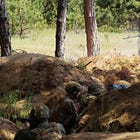The Pokrovsk Gambit
Ukraine has defeated Russia's summer offensive. Now comes the fall offensive

The First Battle of Pokrovsk began more than a year and a half ago. Since then, up to 60,000 Russians have been killed trying to take the Donbas stronghold, according to a spokesman for the Dnipro Operational Strategic Group. Starting the second week of August, a new Russian offensive east of Dobropillya sought to exploit a gap in Ukrainian anti-tank ditches on the New Donbass Line with a combination of infiltration tactics, long-range fiber optic drones, and rapid advances on motorcycles.
But the operation transformed into a cauldron battle, with Russians cut off by a concentration of Ukrainian units, only able to receive resupply by drone. Ukrainians responded very quickly with significant forces, causing some observers to suggest the whole thing had been a clever trap. That is unlikely, as the units had to come from elsewhere in the line of contact. However, over the last five weeks, Ukrainian forces have still not closed this cauldron. It lingers, consuming Russian resources, drawing a new army to the Pokrovsk area, where the Russian Ministry of Defense seems intent on a decisive battle for the Donbas.
They should be careful what they wish for, in the Kremlin. Ukraine has already shaped the battleground for the Second Battle of Pokrovsk to their liking. Since the Kremlin is sending reinforcements into this convenient death ground, Ukraine is happy to receive them there rather than, say, Sumy or Kharkhiv, the points on the line of contact from which Russia is now redeploying units to Pokrovsk. Vladimir Putin is betting everything that he can break the Ukrainian armed forces before his economy breaks. The UAF are betting they can break another Russian army at Pokrovsk before the Russian economy breaks.
Keep reading with a 7-day free trial
Subscribe to Polemology Positions to keep reading this post and get 7 days of free access to the full post archives.


